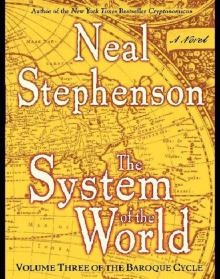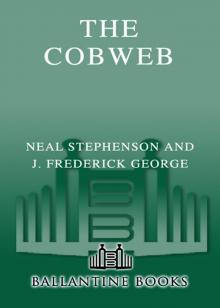- Home
- Neal Stephenson
Mother Earth Mother Board Page 2
Mother Earth Mother Board Read online
Page 2
Copper submarine cables of only a few decades ago could carry only a few dozen circuits - say, about 2,500 kbps total. The first generation of optical-fiber cables, by contrast, carries more than 1,000 times as much data - 280 Mbps of data per fiber pair. (Fibers always come in pairs. This practice seems obvious to a telephony person, who is in the business of setting up symmetrical two-way circuits, but makes no particular sense to a hacker tourist who tends to think in terms of one-way packet transmission. The split between these two ways of thinking runs very deep and accounts for much tumult in the telecom world, as will be explained later.) The second generation of optical-fiber cables carries 560 Mbps per fiber pair. FLAG and other third-generation systems will carry 5.3 Gbps per pair. Or, in the system of units typically used by phone company people, they will carry 60,000 circuits on each fiber pair.
If you multiply 60,000 circuits times 64 kbps per circuit, you get a bit rate of only 3.84 Gbps, which leaves 1.46 Gbps unaccounted for. This bandwidth is devoted to various kinds of overhead, such as frame headers and error correction. The FLAG cable contains two sets of fiber pairs, and so its theoretical maximum capacity is 120,000 circuits, or (not counting the overhead) just under 8 Gbps of actual throughput.
These numbers really knock 'em dead in the phone industry. To the hacker tourist, or anyone who spends much time messing around with computer networks, they seem distinctly underwhelming. All this trouble and expense for a measly 8 Gbps? You've got to be kidding! Again, it comes down to a radical difference in perspective between telephony people and internet people.
In defense of telephony people, it must be pointed out that they are the ones who really know the score when it comes to sending bits across oceans. Netheads have heard so much puffery about the robust nature of the Internet and its amazing ability to route around obstacles that they frequently have a grossly inflated conception of how many routes packets can take between continents and how much bandwidth those routes can carry. As of this writing, I have learned that nearly the entire state of Minnesota was recently cut off from the Internet for 13 hours because it had only one primary connection to the global Net, and that link went down. If Minnesota, of all places, is so vulnerable, one can imagine how tenuous many international links must be.
Douglas Barnes, an Oakland-based hacker and cypherpunk, looked into this issue a couple of years ago when, inspired by Bruce Sterling's Islands in the Net, he was doing background research on a project to set up a data haven in the Caribbean. "I found out that the idea of the Internet as a highly distributed, redundant global communications system is a myth,'' he discovered. "Virtually all communications between countries take place through a very small number of bottlenecks, and the available bandwidth simply isn't that great.'' And he cautions: "Even outfits like FLAG don't really grok the Internet. The undersized cables they are running reflect their myopic outlook.''
So the bad news is that the capacity of modern undersea cables like FLAG isn't very impressive by Internet standards, but the slightly better news is that such cables are much better than what we have now.Here's how they work: Signals are transmitted down the fiber as modulated laser light with a wavelength of 1,558 nanometers (nm), which is in the infrared range. These signals begin to fade after they have traveled a certain distance, so it's necessary to build amplifiers into the cable every so often. In the case of FLAG, the spacing of these amplifiers ranges from 45 to 85 kilometers. They work on a strikingly simple and elegant principle. Each amplifier contains an approximately 10-meter-long piece of special fiber that has been doped with erbium ions, making it capable of functioning as a laser medium. A separate semiconductor laser built into the amplifier generates powerful light at 1,480 nm - close to the same frequency as the signal beam, but not close enough to interfere with it. This light, directed into the doped fiber, pumps the electrons orbiting around those erbium ions up to a higher energy level.
The signal coming down the FLAG cable passes through the doped fiber and causes it to lase, i.e., the excited electrons drop back down to a lower energy level, emitting light that is coherent with the incoming signal - which is to say that it is an exact copy of the incoming signal, except more powerful.
The amplifiers need power - up to 10,000 volts DC, at 0.9 amperes. Since public 10,000-volt outlets are few and far between on the bottom of the ocean, this power must be delivered down the same cable that carries the fibers. The cable, therefore, consists of an inner core of four optical fibers, coated with plastic jackets of different colors so that the people at opposite ends can tell which is which, plus a thin copper wire that is used for test purposes. The total thickness of these elements taken together is comparable to a pencil lead; they are contained within a transparent plastic tube. Surrounding this tube is a sheath consisting of three steel segments designed so that they interlock and form a circular jacket. Around that is a layer of about 20 steel "strength wires" - each perhaps 2 mm in diameter - that wrap around the core in a steep helix. Around the strength wires goes a copper tube that serves as the conductor for the 10,000-volt power feed. Only one conductor is needed because the ocean serves as the ground wire. This tube also is watertight and so performs the additional function of protecting the cable's innards. It then is surrounded by polyethylene insulation to a total thickness of about an inch. To protect it from the rigors of shipment and laying, the entire cable is clothed in good old-fashioned tarred jute, although jute nowadays is made from plastic, not hemp.
This suffices for the deep-sea portions of the cable. In shallower waters, additional layers of protection are laid on, beginning with a steel antishark jacket. As the shore is approached, various other layers of steel armoring wires are added.
This more or less describes how all submarine cables are being made as of 1996. Only a few companies in the world know how to make cables like this: AT&T Submarine Systems International (AT&T-SSI) in the US, Alcatel in France, and KDD Submarine Cable Systems (KDD-SCS) in Japan, among others. AT&T-SSI and KDD-SCS frequently work together on large projects and are responsible for FLAG. Alcatel, in classic French fasion, likes to go it alone.
This basic technology will, by the end of the century, be carrying most of the information between continents. Copper-based coaxial cable systems are still in operation in many places around the world, but all of them will have reached the end of their practical lifetimes within a few years. Even if they still function, they are not worth the trouble it takes to operate them. TPC-1 (Trans Pacific Cable #1), which connected Japan to Guam and hence to the United States in 1964, is still in perfect working order, but so commercially worthless that it has been turned over to a team at Tokyo University, which is using it to carry out seismic research. The capacity of such cables is so tiny that modern fiber cables could absorb all of their traffic with barely a hiccup if the right switches and routers were in place. Likewise, satellites have failed to match some of the latest leaps in fiber capacity and can no longer compete with submarine cables, at least until such time as low-flying constellations such as Iridium and Teledesic begin operating.
Within the next few years, several huge third-generational optical fiber systems will be coming online: not only FLAG but a FLAG competitor called SEA-ME-WE 3 (Southeast Asia-Middle East-Western Europe #3); TPC-5 (Trans-Pacific Cable #5); APCN (Asia-Pacific Cable Network), which is a web of cables interconnecting Japan, Korea, Hong Kong, Taiwan, Malaysia, Thailand, Indonesia, Singapore, Australia, and the Philippines; and the latest TAT (Transatlantic) cable. So FLAG is part of a trend that will soon bring about a vast increase in intercontinental bandwidth.
What is unusual about FLAG is not its length (although it will be the longest cable ever constructed) or its technology (which is shared by other cables) but how it came into existence. But that's a business question which will be dealt with later. First, the hacker tourist is going to travel a short distance up the Malay Peninsula to southern Thailand, one of the two places where FLAG passes overland. On a world map this looks about as dif
ficult as throwing an extension cord over a sandbar, but when you actually get there, it turns out to be a colossal project
7° 3.467' N,100° 22.489' EFLAG manhole production site, southern Thailand
Large portions of this section were written in a hotel in Ban Hat Yai, Thailand, which is one of the information-transfer capitals of the planet regardless of whether you think of information transfer as bits propagating down an optical fiber, profound and complex religious faiths being transmitted down through countless generations, or genetic material being interchanged between consenting adults. Male travelers approaching Ban Hat Yai will have a difficult time convincing travel agents, railway conductors, and taxi drivers that they are coming only to look at a big fat wire, but the hacker tourist must get used to being misunderstood.
We stayed in a hotel with all the glossy accoutrements of an Asian business center plus a few perks such as partially used jumbo condom packages squirreled away on closet shelves, disconcertingly huge love marks on the sofas, and extraordinarily long, fine, black hairs all over the bathroom. While writing, I sat before a picture window looking out over a fine view of: a well-maintained but completely empty swimming pool, a green Carlsberg Beer billboard written in Thai script, an industrial-scale whorehouse catering to Japanese "businessmen," a rather fine Buddhist temple complex, and, behind that, a district of brand-new high-rise hotels built to cater to the burgeoning information-transfer industry, almost none of which has anything to do with bits and bytes. Tropical storms rolled through, lightning flashed, I sucked down European beers from the minibar and tried to cope with a bad case of information overload. FLAG is a huge project, bigger and more complicated than many wars, and to visit even chunks of this cable operation is to be floored by it.
We first met Jim Daily and Alan Wall underneath that big Carlsberg sign, sitting out in a late-afternoon rainstorm under an umbrella, having a couple of beers - "the only ferangs here," as Wall told me on the phone, using the local term for foreign devil. Daily is American, 2 meters tall, blond, blue-eyed, khaki-and-polo-shirted, gregarious, absolutely plain-spoken, and almost always seems to be having a great time. Wall is English, shorter, dark-haired, impeccably suited, cagey, reticent, and dry. Both are in their 50s. It is of some significance to this story that, at the end of the day, these two men unwind by sitting out in the rain and hoisting a beer, paying no attention whatsoever to the industrial-scale whorehouse next door. Both of them have seen many young Western men arrive here on business missions and completely lose control of their sphincters and become impediments to any kind of organized activity. Daily hired Wall because, like Daily, he is a stable family man who has his act together. They are the very definition of a complementary relationship, and they seem to be making excellent progress toward their goal, which is to run two really expensive wires across the Malay Peninsula.
Since these two, and many of the others we will meet on this journey, have much in common with one another, this is as good a place as any to write a general description. They tend to come from the US or the British Commonwealth countries but spend very little time living there. They are cheerful and outgoing, rudely humorous, and frequently have long-term marriages to adaptable wives. They tend to be absolutely straight shooters even when they are talking to a hacker tourist about whom they know nothing. Their openness would probably be career suicide in the atmosphere of Byzantine court-eunuch intrigue that is public life in the United States today. On the other hand, if I had an unlimited amount of money and woke up tomorrow morning with a burning desire to see a 2,000-hole golf course erected on the surface of Mars, I would probably call men like Daily and Wall, do a handshake deal with them, send them a blank check, and not worry about it.
Daily works out of Bangkok, the place where banks are headquartered, contracts are written, and 50-ton cranes are to be had. Alan "the ferang" Wall lives in Ban Hat Yai, the center of the FLAG operation in Thailand, cruising the cable routes a couple of times a week, materializing unpredictably in the heart of the tropical jungle in a perfectly tailored dark suit to inspect, among other things, FLAG's chain of manhole-making villages.
There were seven of these in existence during the summer of 1996, all lying along one of the two highways that run across the isthmus between the Andaman and the South China Seas. These highways, incidentally, are lined with utility poles carrying both power and communications wires. The tops of the poles are guarded by conical baskets about halfway up. The baskets prevent rats from scampering up the poles to chew away the tasty insulation on the wires and poisonous snakes from slithering up to sun themselves on the crossbars, a practice that has been known to cause morale problems among line workers.
The manhole-making village we are visiting on this fine, steamy summer day has a population of some 130 workers plus an unknown number of children. The village was founded in the shade of an old, mature rubber plantation. Along the highway are piles of construction materials deposited by trucks: bundles of half-inch rebar, piles of sand and gravel. At one end of the clearing is a double row of shelters made from shiny new corrugated metal nailed over wooden frames, where the men, women, and children of the village live. On the end of this is an open-air office under a lean-to roof, equipped with a whiteboard - just like any self-respecting high tech company. Chickens strut around flapping their wings uselessly, looking for stuff to peck out of the ground.
When the day begins, the children are bused off to school, and the men and women go to work. The women cut the rebar to length using an electric chop saw. The bars are laid out on planks with rows of nails sticking out of them to form simple templates. Then the pieces of rebar are wired together to create cages perhaps 2 meters high and 1.5 meters on a side. Then the carpenters go to work, lining the cage inside and out with wooden planks. Finally, 13 metric tons of cement are poured into the forms created by the planks. When the planks are taken away, the result is a hollow, concrete obelisk with a cylindrical collar projecting from the top, with an iron manhole cover set into it. Making a manhole takes three weeks.
Meanwhile, along the highway, trenches are being dug - quickly scooped out of the lowland soil with a backhoe, or, in the mountains, laboriously jackhammered into solid rock. A 50-ton crane comes to the village, picks up one manhole at a time using lifting loops that the villagers built into its top, and sets it on a flatbed truck that transports it to one of the wider excavations that are spaced along the trench at intervals of 300 to 700 meters. The manholes will allow workers to climb down to the level of the buried cable, which will stretch through a conduit running under the ground between the manholes.
The crane lowers the manhole into the excavation. A couple of hard-hatted workers get down there with it and push it this way and that, getting it lined up, while other workers up on the edge of the pit help out by shoving on it with a big stick. Finally it settles gingerly into place, atop its prepoured pad. The foreman clambers in, takes a transparent green disposable lighter from his pocket, and sets it down sideways on the top of the manhole. The liquid butane inside the lighter serves as a fluid level, verifying that the manhole is correctly positioned.
With a few more hours' work, the conduits have been mated with the tubes built into the walls of the manhole and the surrounding excavation filled in so that nothing is left except some disturbed earth and a manhole cover labeled CAT: Communications Authority of Thailand. The eventual result of all this work will be two separate chains of manholes (931 of them all told) running parallel to two different highways, each chain joined by twin lengths of conduit - one conduit for FLAG and one for CAT.
Farther west, another crew is at work, burdened with three enormous metal spools carrying flexible black plastic conduit having an inside diameter of an inch. The three spools are set up on stands near a manhole, the three ducts brought together and tied into a neat bundle by workers using colorful plastic twine. Meanwhile, others down in the manhole are wrestling with the world's most powerful peashooter: a massive metal pipe with a sc
rew jack on its butt end. The muzzle of the device is inserted into one of the conduits on the manhole wall and the screw jack is tightened against the opposite wall to hold it horizontal. Next the peashooter is loaded: a big round sponge with a rope tied to it is inserted into an opening on its side. The rope comes off a long spool. Finally, a hefty air compressor is fired up above ground and its outlet tube thrown down into the manhole and patched into a valve on this pipe. When the valve is opened, compressed air floods the pipe behind the round sponge, which shoots forward like a bullet in a gun barrel, pulling the rope behind it and causing the reel to spin wildly like deep-sea fishing tackle that has hooked a big tuna.
"Next manhole! Next manhole!" cries the foreman excitedly, and pedestrians, bicyclists, motor scooters, and (if inspectors or hacker tourists are present) cars parade down the highway, veering around water buffaloes and goats and chickens to the next manhole, some half a kilometer away, where a torrent of water, driven before the sponge, is blasting out of a conduit and slamming into the opposite wall. One length of the conduit can hold some 5 cubic meters of water, and the sponge, ramming down the tube like a piston, forces all of it out. Finally the sponge pops out of the hole like a pea from a peashooter, bringing the rope with it. The rope is used to pull through a thicker rope, which is finally connected to the triple bundle of thin duct at one end and to a pulling motor at the other. This pulling motor is a slowly turning drum with several turns of rope around it.
Now the work gets harder: at the manhole with the reels, some workers bundle and tie the ducts as they unroll while others, down in the hole, bend them around a difficult curve and keep them feeding smoothly into the conduit. At the other end, a man works with the puller, keeping the tension constant and remaining alert for trouble. Back at the reels, the thin duct occasionally gets wedged between loose turns on the reel, and everything has to be stopped. Usually this is communicated to the puller via walkie-talkie, but when the afternoon rains hit, the walkie-talkies don't work as well, and a messenger has to buzz back and forth on a motor scooter. But eventually the triple inner duct is pulled through both of the conduits, and the whole process can begin again on the next segment.

 Zodiac: The Eco-Thriller
Zodiac: The Eco-Thriller The Mongoliad: Book One
The Mongoliad: Book One Snow Crash
Snow Crash The Confusion: Volume Two of the Baroque Cycle
The Confusion: Volume Two of the Baroque Cycle The Rise and Fall of D.O.D.O.
The Rise and Fall of D.O.D.O. The Diamond Age: Or, a Young Lady's Illustrated Primer
The Diamond Age: Or, a Young Lady's Illustrated Primer The Big U
The Big U The System of the World: Volume Three of the Baroque Cycle
The System of the World: Volume Three of the Baroque Cycle The Cobweb
The Cobweb Reamde
Reamde Fall; or, Dodge in Hell
Fall; or, Dodge in Hell Interface
Interface Quicksilver
Quicksilver The Mongoliad: Book Three
The Mongoliad: Book Three Seveneves
Seveneves Atmosphæra Incognita
Atmosphæra Incognita In the Beginning...Was the Command Line
In the Beginning...Was the Command Line Anathem
Anathem The Rise and Fall of D.O.D.O.: A Novel
The Rise and Fall of D.O.D.O.: A Novel The Mongoliad: Book Two
The Mongoliad: Book Two Diamond Age or a Young Lady's Illustrated Primer
Diamond Age or a Young Lady's Illustrated Primer THE System OF THE WORLD
THE System OF THE WORLD The Mongoliad: Book One tfs-1
The Mongoliad: Book One tfs-1 Some Remarks: Essays and Other Writing
Some Remarks: Essays and Other Writing Zodiac
Zodiac Spew
Spew The Baroque Cycle: Quicksilver, the Confusion, and the System of the World
The Baroque Cycle: Quicksilver, the Confusion, and the System of the World The Diamond Age
The Diamond Age Reamde: A Novel
Reamde: A Novel In the Kingdom of Mao Bell
In the Kingdom of Mao Bell Mother Earth Mother Board
Mother Earth Mother Board Twelve Tomorrows - Visionary stories of the near future inspired by today's technologies
Twelve Tomorrows - Visionary stories of the near future inspired by today's technologies The Confusion
The Confusion The Great Simoleon Caper
The Great Simoleon Caper The Mongoliad: Book Three tfs-3
The Mongoliad: Book Three tfs-3